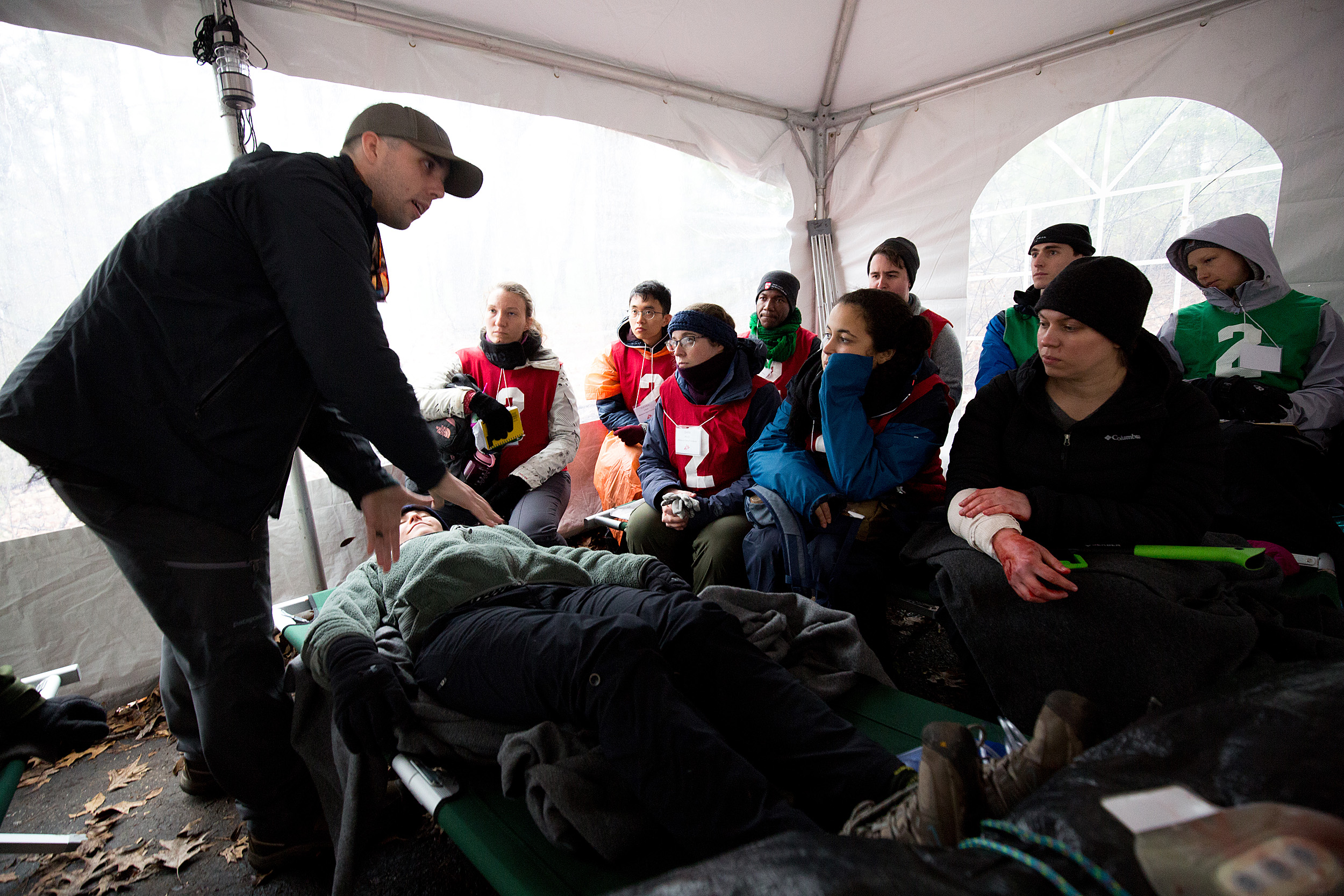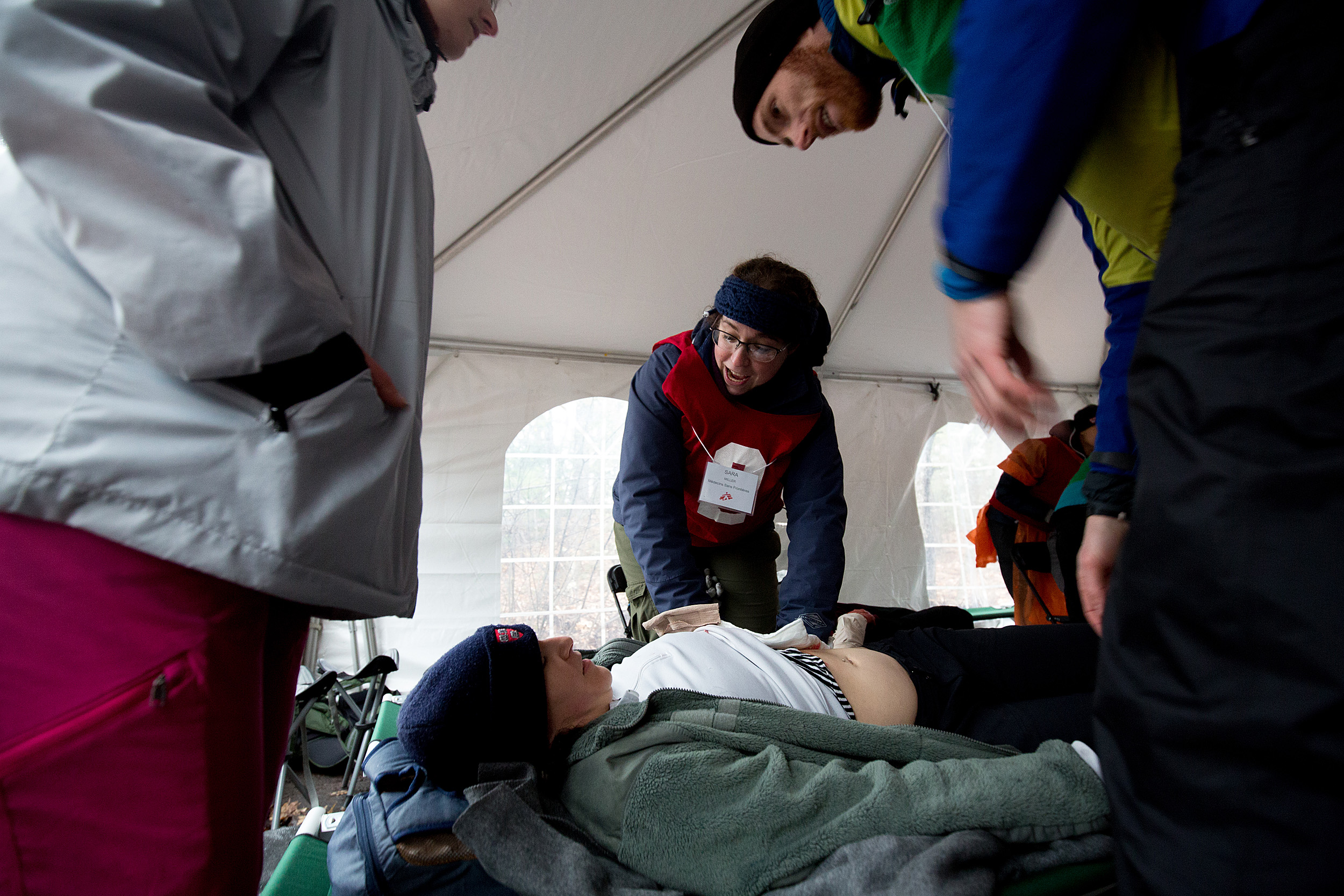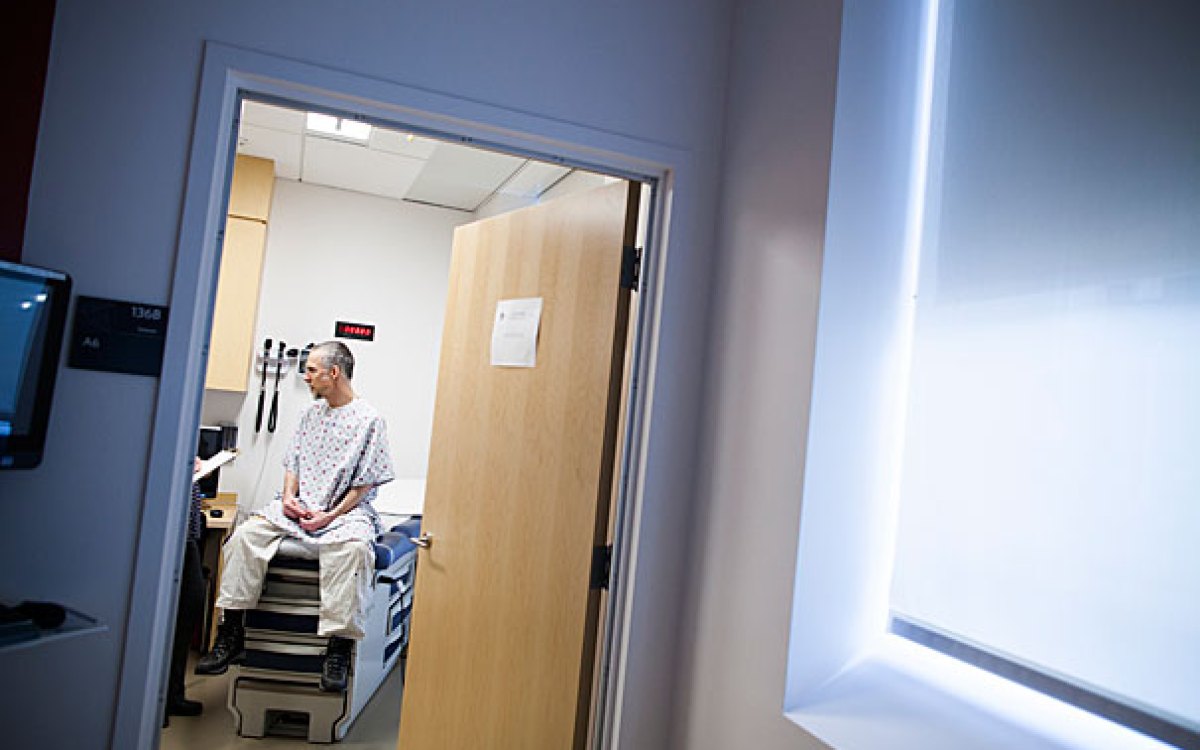Video by Justin Saglio/Harvard Staff
In the cold and rain, a sprawling lesson on caring
3-day humanitarian disaster simulation brings hundreds to North Andover state park
“We have a saying in the simulation: ‘Rain is educational,’” Stephanie Kayden said, considering the cold, wet New England forest around her on a drizzly spring day.
Across the surrounding landscape, 115 students from Harvard, Tufts, and the Massachusetts Institute of Technology were getting a firsthand taste of life as humanitarian aid workers. Divided into 18 teams, they were spread along the roads, lakefront, and trees of Harold Parker State Forest. They interacted with 140 volunteers — some of whom were tasked with giving them a very hard time — who staffed a faux United Nations headquarters, border checkpoints, field hospital, and refugee camps.
“The goal is to put just enough stress on the students so that they know how to do their work under duress,” said Kayden, director of Harvard’s Lavine Family Humanitarian Studies Initiative. “We make them feel what it’s like to really be an aid worker, when they’re cold, stressed, tired, hungry, and running out of time.”
Kayden, who is also an associate professor at Harvard Medical School and at the Harvard T.H. Chan School of Public Health and chief of Brigham and Women’s Hospital’s Division of International Emergency Medicine and Humanitarian Programs, is responsible for overseeing the sprawling simulated disaster that takes over a chunk of the forest in North Andover for a weekend each spring.
This year’s version transported students to the volatile border in the imaginary nation of Worani, where a series of devastating storms have pushed the area’s farmers from their lands. Complicating things is an ongoing conflict in the nation next door that sometimes spills over the border. Organizers emphasize providing as real and immersive an experience as possible, and have designed the weekend to put students off balance, ratchet up stress, and spring at least a few adrenaline-inducing surprises that challenge students to maintain focus and stay on task.
“This is the only way they’ll get experience in a setting like this before they’ll have to do it for real,” Kayden said.
The student teams were playing the roles of well-known aid agencies, such as the International Committee of the Red Cross, Doctors Without Borders, and Save the Children. They interacted with volunteers posing as refugees suffering an array of health and safety concerns. The students’ mission was to discover what had happened, what the people’s needs were, and how best to help. Other volunteers played local residents, officials, or members of the military or a local militia.
The simulation is a training program of the Harvard Humanitarian Initiative. About half of the students participating are enrolled in humanitarian studies classes at the Harvard Chan School and the other half are mid-career professionals — some of whom already have field experience — taking an intensive executive education program offered by the Humanitarian Academy at Harvard, which oversees humanitarian education programs at the University.
Sarah Klem, a master’s of public health student at the Harvard Chan School who was at the simulation, said she became interested in humanitarian work after working on Lesbos, a Greek island just off the Turkish coast that is a stop for refugees on their way to Europe.
“There’s just a lot of need that mostly isn’t talked about,” Klem said. “There’s a lot to do.”


Participants practiced disaster drills, including how to treat injuries.
Justin Saglio/Harvard Staff
Ahmed Nasser, a Jordanian doctor working on a master’s of public health degree at the Harvard Chan School, said he became interested in humanitarian work when he worked with Doctors Without Borders after finishing medical school.
“I fell in love with what they do,” Nasser said. “It wasn’t just the organization itself, it was mainly helping people. That’s why I went into medicine, that’s why I’m interested in humanitarian work.”
Nasser and Klem were among a group that interviewed refugees at a simulated camp set up on the park’s breezy lakefront. One “refugee” was Benjamin Aiwonodagbon, a Nigerian doctor, Harvard Chan School graduate, and currently a research fellow at the Brigham. Aiwonodagbon was a student at the simulation last year and said it opened his eyes to the skills needed for humanitarian work.
“It kind of resonated with me because my country right now has a lot of security issues,” Aiwonodagbon said. “It gave me an experience [and the sense that] there’s a need to learn more and a need to be a little bit more engaged as a physician.”
One of the students’ stops is a field hospital set up and staffed by Massachusetts General Hospital’s Global Disaster Response Program. The program’s deputy director of field operations, Lindsey Martin, described the field hospital as “a simulation within a simulation” because the MGH program brought its own group of trainees — clinicians interested in disaster response. Their task for the weekend wasn’t to conduct rapid assessments or otherwise handle humanitarian response, but instead to learn how to set up a field hospital in a disaster zone.
The field hospital was also an important stop for the teams of student humanitarian workers. On arrival, they were given a crash course in emergency triage, which barely concluded before a crowd of refugees poured in for 10 minutes of pandemonium, bleeding, shouting, demanding aid until the students got the situation in hand.
Afterward, students were debriefed and critiqued, with pointers one might not initially think of — like “keep an eye out for weapons” — that are important in humanitarian settings.
Martin said the weekend is important for the MG trainees, who get a taste of what awaits them in the field, as well as for the larger population of humanitarian students, who are forced to apply lifesaving skills taught in the classroom.
“People should step up and be leaders, there should be a relative amount of calm,” Martin said. “But our goal is to create as much chaos as possible, for them to barely be able to think. And they have to respond.”
The weekend, Martin said, also gives organizers a chance to reconnect with colleagues whom they will likely meet in the field sometime in the future.
“We like to say, ‘We see you here, we’ll see you again,’” Martin said.






